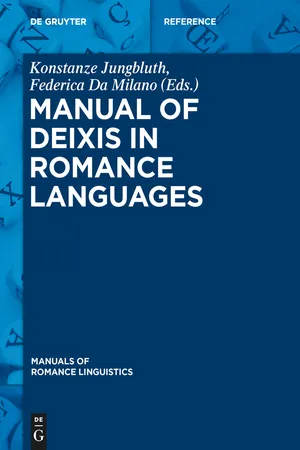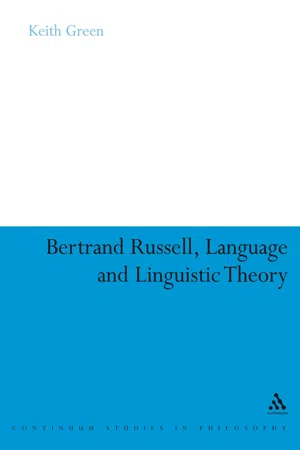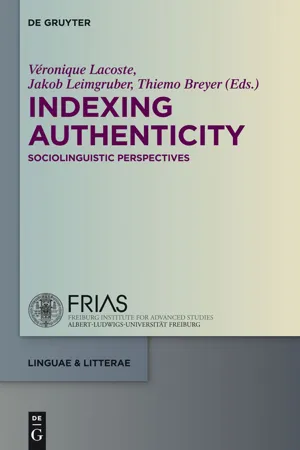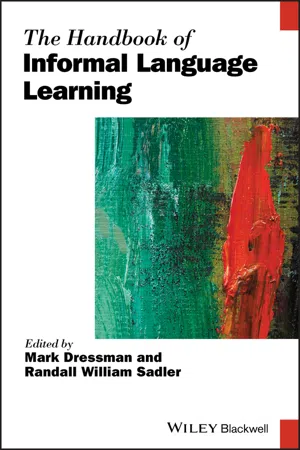Languages & Linguistics
Indexicality
Indexicality refers to the way language is used to point to specific people, places, or times. It is the ability of language to refer to the context in which it is used, and it is an important aspect of communication. Indexical expressions include pronouns, demonstratives, and tense markers.
Written by Perlego with AI-assistance
Related key terms
7 Key excerpts on "Indexicality"
- eBook - ePub
Socializing Identities through Speech Style
Learners of Japanese as a Foreign Language
- Haruko Minegishi Cook(Author)
- 2008(Publication Date)
- Multilingual Matters(Publisher)
This book draws on language socialization (Ochs, 1988, 1990, 1996; Ochs & Schieffelin, 1995; Schieffelin & Ochs, 1986, 1996) and a theory of Indexicality (e.g. Hanks, 1990, 2000; Ochs, 1990; Silverstein, 1976), both of which are founded on the assumption that language is an integral part of the social world. This introduction briefly discusses the indexical approach and language socialization as they relate to the study of this book. It also summarizes the significance of an indexical approach in examining the so-called ‘addressee honorific form’ in Japanese. An Indexical Approach: Language as an Integral Part of the Social World In an indexical approach, language is a socially organized phenomenon, and meaning is not a sole property of language but is situated and negotiated in social context (cf. Duranti & Goodwin, 1992; Gumperz & Levinson, 1996; Hanks, 1990, 2000). A linguistic form has the potential of taking on a variety of meanings. For example, the linguistic expression here points to a place closer to the speaker, which is the literal meaning of here. When this meaning is used in context, the indexical function of language can evoke multiple social meanings. If the speaker is standing by the table in the room here refers to the area where the table is located. If the speaker is standing by the door, here denotes the area where the door is located. If the speaker points to the window by her side and utters ‘Here!’, then this expression refers to the window. In each instance, the linguistic expression here indexes a different object in the immediate situation. This function of language has also been referred to as deictic function, and classic examples of deixis are person, place and time (cf. Levinson, 1983). The indexical function, however, is not limited to person, place or time deixis - eBook - ePub
- Konstanze Jungbluth, Federica Da Milano, Konstanze Jungbluth, Federica Da Milano(Authors)
- 2015(Publication Date)
- De Gruyter(Publisher)
in praesentia , and in a specific context (↗16 Contextualism). Through audio/ visual face-to-face interaction, speakers provide their audience with relevant information about themselves, i.e. their personhood, stance and representations. In this chapter I will use the concept of ‘indexical cloud’ (↗17 Indexicalism) as a background ‘cover concept’ inside which core deictic forms exist and are implemented.The main thrust of this paperWhile all languages have in theirWhile all languages have in is that a central function of deictic forms is the relational one, connected to, but not determined by, their core meanings which usually refer to one of the three main categories of ‘person’, ‘time’, and ‘space’. While each deictic form carries in itself, to varying degrees, one or another of the above values, at the same time it expresses, to different degrees, pervasive indexical contents moulded all the time by social actors (i.e., speakers and audience) through their speech and action (↗27 Social Interaction).Subclasses of deictics, such as pronouns, demonstratives, space and time adverbs, as well as tense/person markings on verbs, or possessives (mostly 1st and 2nd person nominal possessives), should be conceived of not as clear-cut domains, but rather as subsets somehow floating along, and even reciprocally overlapping in their synchronic implementation, as well as across time (Gnerre/Fabrizio 2010 ; ↗22 From Latin and Vulgar Latin to Romance Languages; ↗21 Typology).The above preliminary statements are particularly relevant to introduce this chapter, which focuses on Mesoamerican languages (from now on, MA), spoken mostly in small communities, and only rarely written. The cultural-sociolinguistic features of community size and literacy are very relevant for the relation between the indexical cloud and core deictics. In fact, in small communities, the cloud of implicit references to the speaking self, to other participants in the speech act (SAP), let alone non-SAP and the context, can be very large. - eBook - ePub
- Keith Green(Author)
- 2007(Publication Date)
- Continuum(Publisher)
iv. The designatum is directly sensed, v. They designate particulars.The way is open for Russell here to synthesize seemingly opposing indexical functions, for rather than seeing such particulars as representing an unresolvable conflict between subjective and objective worlds he can posit indexicals as representing the location of objects within the content of subjective experience. In this way another seeming puzzle is resolved – that of how they can be at once context-dependent and unambiguous.Given that the analysis of indexicals leads to the heart of a number of important philosophico-linguistic problems, it is surprising how little attention was given to them by mainstream linguists in the first half of the twentieth century. It is true that philosophical inquiry, despite the work of Peirce, also did not fully develop until the middle years, Buhler’s Sprachtheorie having been published only in 1934; but it seems that linguistics lagged some years behind. There is no mention of such elements in Bloomfield’s Language (1933), and nothing in the work of Sapir, Trubetskoy or Malinowski. Jesperson (1923) touches on the issue in his discussion of tense. The lack of analyses of such elements is all the more remarkable considering the following comment by Steven Levinson:The many facets of deixis [indexicals] are so pervasive in natural languages, and so deeply grammaticalised, that it is hard to think of them as anything other than as an essential part of semantics. (Levinson, 1983: 55)Indexicals, as Levinson further suggests, function within both semantic and pragmatic boundaries. Although he rightly considers them to be deeply grammaticalized in the language, one reason for their relative under-analysis in works by major linguists before the Second World War is that they were considered an aspect of semantics — a relatively new branch of study. Russell, however, had anticipated the major work on deixis within both philosophy and linguistics and attempted to incorporate his considerations on the phenomenon within a theory of the mind – no mean feat for a philosopher ‘uninterested in language’ and antipathetic to ‘linguistic philosophy’. - eBook - ePub
- Véronique Lacoste, Jakob Leimgruber, Thiemo Breyer, Véronique Lacoste, Jakob Leimgruber, Thiemo Breyer(Authors)
- 2014(Publication Date)
- De Gruyter(Publisher)
Authenticity has long been an elephant in the room in the study of sociolinguistic variation. It is embedded in the notion of the vernacular, in our relation to the rest of the field of linguistics, in our field methods, and in prevalent understandings of the nature of the indexical nature of variation. The vernacular emerged early on in the study of variation as the holy grail of language study – as the authentic production of the authentic speaker, the natural object of scientific investigation. Labov (1972) defined the vernacular as the speaker’s most automatic linguistic production, directly produced by, and reflective of, the speaker’s grammar. This production, free of interference from conscious processes, could be witnessed only in the most unreflective, spontaneous, speech untainted by the corrective forces of standard norms. The ultimate inauthentic speaker emerged as the middle class speaker, seen as suppressing the vernacular in response to the demands of the standard language market (Bourdieu and Boltanski 1975). Labov (1972) characterized middle class speech as more self-conscious and contrived than working class speech, and Kroch (1978) suggested that the socioeconomic stratification of variation results from stratified resistance to vernacular innovation. In other words, class emerges as a cline of (in)authenticity. Equally inauthentic are speakers who do not produce the language of their assigned population group, such as middle class Nathan B., whom Labov eliminated from his New York City (Labov 1966) sample for his consistent use of a working class pattern. In other words, authenticity in this tradition is based on conformity to membership in enduring structural categories, and linguistic authenticity entails using the patterns of variation associated with those categories. Authenticity, then, is something the analyst bestows on speakers and their speech performances.Over the years, though, leading up to the current Third Wave of variation studies (Eckert 2012), we have come to view variation as a more robust and dynamic indexical system. Correlations with abstract demographic categories such as gender and class are not the source of Indexicality, but the outcome, resulting from patterns of activity that constitute those categories. In turn the broader structure acts as constraint on those patterns of activity so that there is a continuous reproductive relation between structure and practice. Variation enters into stylistic configurations as speakers construct personae in the moment and through time – personae, needless to say, that may inhabit the broader categories into which they fit, but also personae that don’t quite fit the categories, that push the envelope and bring about change. And just as new concepts require new words (e.g. software, metrosexual ), ever-changing social dynamics require ever-changing indexical resources. The mechanism for indexical change is what Silverstein (2003) has called indexical order - eBook - ePub
- Yoko Hasegawa(Author)
- 2013(Publication Date)
- Routledge(Publisher)
2.4. Indexical Meaning 2.4.1. Indexicality Consider the following three passages:A. おれさあ、先月、検査したんだけど、コレステロール高いんだっ てさ。だから、肉食うのやめたんだ。最初はかなりきつかったけ ど、慣れると、野菜もけっこうおいしいよね。B. うちな、先月、検査してもろたら、コレステロール高いて言われ たんよ。そやから、菜食主義に変えてみたんや。最初はちょっと きつかったんやけど、この頃は野菜もおいしいって思うようにな ってん。C. 先月、健康診断をいたしましたが、コレステロールが少し高いの だそうです。それで、菜食主義に転向いたしました。最初はつら かったのですが、慣れると、野菜もおいしいものだと思うように なりました。While they are more or less synonymous regarding propositional and expressive meanings, they evoke different information about the speakers and their speech situations. The speaker of A is likely a man, while the speaker of B is likely a woman from the Kansai region. The A and B speech situations are casual conversations; C is uttered in a more formal situation such as a job interview. Could such information/meanings be attributable to specific words in the text? In A, for example, in many dialects, including that of Tokyo, the use of ore normally signals that the speaker is a male. Is the information regarding the speaker’s sex then part of the meaning of ore?In recent years, following the work of Charles Sanders Peirce (1839–1914) (Peirce and Hoopes 1991), these types of meanings are accounted for in terms of Indexicality, i.e. the relationship between a linguistic expression and its context.13 Indexicality is defined as follows: a sign A indexes information C when the occurrence of A can imply the presence or existence of C (Lyons 1977: 106). For example, when we say “Smoke means fire,” smoke is an index that implies the presence of fire. In another example, the presence of ore implies that the speaker is male, as well as that the speech situation is casual, or, if the speaker is in fact a woman, that the speech is in a dialect such as that of Saitama prefecture, where ore is used by both sexes. Let us refer to such meanings as indexical meaning.According to this view, language practice involves indexing a multiplicity of sociocultural significances (i.e. meanings), including the spatiotemporal locus of the communicative situation (i.e. deixis, e.g. I, you, here, there, now, then - eBook - ePub
- Siân Preece, Siân Preece, Siân Preece(Authors)
- 2016(Publication Date)
- Routledge(Publisher)
I will briefly describe what MCA, Indexicality and positioning involve. MCA (Hester and Englin 1997; Antaki and Widdicombe 1998) is the study of ways in which participants in spoken interaction invoke social categories of belonging (for example, ethnic or national categories) and the meanings that they assign to those categories. The most prominent representatives of this methodology work within the frame of conversation analysis (see Benwell and Stokoe, this volume), but the study of how social categories are applied and understood is widely used by discourse analysts from different orientations such as critical discourse analysts (see Wodak et al. 1999) and interactional sociolinguists (De Fina 2006). Another very popular construct in the study of identities is the concept of ‘Indexicality’ (Silverstein 1976), which refers to the ability of linguistic elements that include single sounds, words and combinations of resources to evoke particular associations with identities, such as groups or social personae, and cultural constructs, such as ways of life, values and so forth, that are characteristic of those groups. Indexicality is central to an understanding of social semiosis as continuously evolving and of meanings as profoundly contextualised, since the assumption is that any linguistic or semiotic element or combination of elements can become socially significant. Research on styles (for an overview see Coupland 2007) has taken Indexicality as a fundamental construct. Finally, ‘positioning’ is also widely used in the analysis of identities. Positioning has been interpreted as capturing social agents’ stances and evaluations of their and others’ roles, ideas, actions, etc. The analysis of positioning is based on both indexical processes and on the use of explicit evaluations and categories - eBook - ePub
- Mark Dressman, Randall William Sadler, Mark Dressman, Randall William Sadler(Authors)
- 2019(Publication Date)
- Wiley-Blackwell(Publisher)
It might seem, then, that in this case it is a linguistic sign that supplies the meaning of the meme. However, without the photo, notice that the proposition itself is meaningless. Bronwyn Bishop is “just walking her dog”: So, what? With the image, however, possible meanings are now indexed: Bronwyn Bishop is in the helicopter; the dog is hers; she's walking it. But why? If only we knew who Bronwyn Bishop was. The meme as a whole, then, becomes a rhematic iconic legisign, or Sign type 5 that points or directs our attention toward further understanding (requiring one, perhaps, to google “Bronwyn Bishop”), although for Australians or those familiar with Australian politics it might be considered a rhematic symbol (Sign type 8) of the state of Australian politics or even a dicent symbol (Sign type 9), a proposition about the state of Australian politics. In either case, the relationship between image(s) and written text is a reciprocal one, in which each points to the other to create a more fully developed understanding of its implications, or meaning.How, then, does the principle of reciprocal Indexicality contribute to informal language learning? Let's consider the example of a captioned video, in which an audio voice track is combined with its captioned transcription and a series of video images that are the visual representation of (and that index) the meaning of the audio track and transcribed captions (for an example, watch this video in Spanish about making chocolate chip cookies: https://youtube/‐Ma4xsmQV98 ). In this example, reciprocity happens in at least two ways. First, the visual signs of recognizable objects and actions provide a concrete and almost visceral level of understanding to what is being talked about, or represented in linguistic, symbolic terms. Second, the written, transcribed captions visually index the spoken language of the video, pointing to individual words, to the phonetic transcription of words, and to aspects of language that are often elided in speech. In combination, the reciprocity between images and language and between spoken and written forms of language provides a context for language learning that is immediate, meaningful across multiple levels of understanding, and when the topic is of interest to a learner, highly engrossing.The principle of indexical reciprocity of multimodal texts is a powerful tool for language learning because it dramatically increases the amount and quality of comprehensible input available to a learner (Krashen 1985 ). In Vygotskian (Vygotsky 1980
Index pages curate the most relevant extracts from our library of academic textbooks. They’ve been created using an in-house natural language model (NLM), each adding context and meaning to key research topics.






